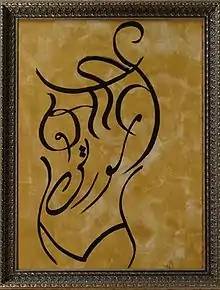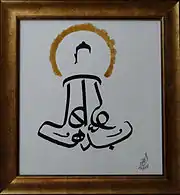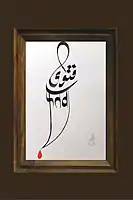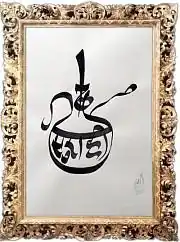Samrup Rachna
Samrup Rachna is a form of calligraphic art created by Dr Syed Mohammed Anwer to promote peace and collaboration in the South Asia region where Hindustani is spoken[1][2][3][4][5][6][7]

The name comes from the Sanskrit words Samrup (सामरुप) (سامروپ), meaning "congruence" or similar, and Rachna (रचना) (رچنا) meaning "creative work or design".[8] The calligraphy is an attempt to use the two altogether different Devanagari and Nastaʿlīq script scripts, used by the same language Hindi -Urdu, in unison in such a manner that a picture of the word which is written is formed.This work is acknowledged by Indian and Pakistani print media also.[9][10][11][12][13][14][15]
For example, the Hindustani word surahi (meaning "ewer" or "pitcher" in English) is written in Samrup Rachna calligraphy in Devanagri[16] and Nastaʿlīq[17] scripts of Hindustani in a way that a picture of a ewer is formed.[18][19]
In linguistics, languages which are written in two different scripts are called Synchronic digraphia. Hindustani is one such language.[20] Samrup Rachna is also advocated by its inventor to help readers of Nastaʿlīq (Urdu) script to understand and learn the Devanagari (Hindi) script of the same language. This art is aimed at helping to dispel the existing religious association with the two scripts in the region of South Asia.[21][22]
A unique linguistic cum calligraphic art book, Samrup Rachna – Calligraphic Expression of Apni Boli [Hindi-Urdu] was launched at the Mother Languages Literature Festival[23] held at the National Institute of Folk and Traditional Heritage ( Lok Virsa), Islamabad, in collaboration with USAID Agency and some other NGOs including Indus cultural Forum ( ICF) on 20 February 2016, by Dr. Syed Mohammed Anwer contains over 60 visual impressions of words with cultural connotations created out of the Hindi Devanagari script and the Urdu Nastaliq script.[24] Beautifully presented in hardback form the book is as much a socio-political comment as a coffee table art book.[15] Dr. Anwer learnt the Devanagari script from his mother. The two scripts are essentially “the same language, written differently” as explained by the artist's mother. The purpose of the Book is to highlight the fact that association of any language or its script with any particular religion is a fundamental mistake.[12] Language has no religion.[25] The book can also be used as ‘easy-to-learn’ book for the ‘other’ script of Apni Boli [Hindi-Urdu] by its speakers.[24]
The author of Samrup Rachna Calligraphic Expression of Apni Boli [Hindi-Urdu] is an advocate of the Supreme Court of Pakistan and is a PhD on the topic of human rights from Punjab University. The polymath is also an active member of the civil society and has remained elected President of Islamabad Bar Association in 2013.[26] He has also written books on human rights, women's emancipation and other social issues.[12][15]
_is_written_in_Samrup_Rachna_calligraphy_by_Dr._Syed_Mohammed_Anwer..JPG.webp) "Juta" ( shoe) written in Samrup Rachna calligraphy
"Juta" ( shoe) written in Samrup Rachna calligraphy "Buddha" written in Samrup Rachna calligraphy
"Buddha" written in Samrup Rachna calligraphy "Fatwa" written in Samrup Rachna Calligraphy
"Fatwa" written in Samrup Rachna Calligraphy "Surahi" in samrup rachna calligraphy
"Surahi" in samrup rachna calligraphy
References
- "About Hindi-Urdu". North Carolina State University. "Archived copy". Archived from the original on 2009-08-15. Retrieved 2009-08-09.CS1 maint: archived copy as title (link). Retrieved 2009–08–09.
- Michael Huxley (editor) (1935), The Geographical magazine, Volume 2, Geographical Press, https://books.google.com/books?id=Z1xOAAAAIAAJ, "... For new terms it can draw at will upon the Persian, Arabic, Turkish and Sanskrit dictionaries ..."
- Royal Society of Arts, Great Britain (1948), Journal of the Royal Society of Arts, Volume 97, https://books.google.com/books?id=fx_SAAAAMAAJ, "... it would be very unwise to restrict it to a vocabulary mainly dependent upon Sanskrit, or mainly dependent upon Persian. If a language is to be strong and virile it must draw on both sources, just as English has drawn on Latin and Teutonic sources ..."
- Robert E. Nunley, Severin M. Roberts, George W. Wubrick, Daniel L. Roy (1999), The Cultural Landscape an Introduction to Human Geography, Prentice Hall, ISBN 0-13-080180-1, https://books.google.com/books?id=7wQAOGMJOqIC, "... Hindustani is the basis for both languages ..."
- Hindi by Yamuna Kachru
- Students' Britannica: India: Select essays by Dale Hoiberg, Indu Ramchandani page 175 is spoken and understood
- "Over distances of calligraphy to a new dimension in the region" (in Urdu). Voice of America. 13 April 2012.
- "زبان قربتوں کا ذریعہ نا کہ دوریوں کا".
- "Pak lawyer fuses Urdu, Hindi in calligraphy". 1 February 2016.
- "Archived copy". Archived from the original on 2016-03-03. Retrieved 2016-02-24.CS1 maint: archived copy as title (link)
- "Unique linguistic art book launched". www.thenews.com.pk.
- "case - The Express Tribune Epaper". epaper.tribune.com.pk.
- Desk, Web (22 February 2016). "Hindi-Urdu fusion in unique calligraphic art - TheNewsTribe".
- "Archived copy". Archived from the original on 2016-03-09. Retrieved 2016-02-24.CS1 maint: archived copy as title (link)
- آباد, شیراز حسن بی بی سی اردو ڈاٹ کام، اسلام. "'زبان کو مذہب سےجوڑنا زبان سے ناانصافی ہے'". BBC News اردو.
- Isaac Taylor (2003), History of the Alphabet: Aryan Alphabets, Part 2, Kessinger Publishing, ISBN 9780766158474, https://books.google.com/books?id=kLlBuOybNMQC, "... In the Kutila this develops into a short horizontal bar, which, in the Devanagari, becomes a continuous horizontal line ... three cardinal inscriptions of this epoch, namely, the Kutila or Bareli inscription of 992, the Chalukya or Kistna inscription of 945, and a Kawi inscription of 919 ... the Kutila inscription is of great importance in Indian epigraphy, not only from its precise date, but from its offering a definite early form of the standard Indian alphabet, the Devanagari ..."
- The Cambridge History of Islam, By P. M. Holt, et al., Cambridge University Press, 1977, ISBN 0521291380, p. 723.
- Urdu VOA (13 April 2012). "Syed Mohammad Anwar - Calligraphy Artist" – via YouTube.
- "Archived copy". Archived from the original on 2016-03-21. Retrieved 2016-03-18.CS1 maint: archived copy as title (link)
- Cheung, Yat-Shing (1992). "The form and meaning of digraphia: the case of Chinese". In K. Bolton and H. Kwok. Sociolinguistics Today: International Perspectives. London: Routledge.
- "Hindi-Urdu is a single spoken language` - ePaper - DAWN.COM". epaper.dawn.com.
- Syed Mohammed Anwer (17 May 2010). "The Hindi-Urdu question". The News International.
- "Archived copy". Archived from the original on 2016-03-02. Retrieved 2016-02-23.CS1 maint: archived copy as title (link)
- http://www.urdutribe.com/2016/02/21/6886
- "'Language has no religion': Pakistani lawyer fuses Urdu, Hindi in calligraphy - The Express Tribune". 3 February 2016.
- "Archived copy". Archived from the original on 2016-03-03. Retrieved 2016-02-23.CS1 maint: archived copy as title (link)